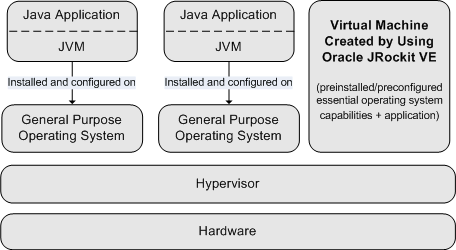| Oracle® Fusion Middleware User's Guide for Oracle JRockit Virtual Edition 11g Release 1 (11.1.1.3.1) Part Number E15206-03 |
|
|
View PDF |
| Oracle® Fusion Middleware User's Guide for Oracle JRockit Virtual Edition 11g Release 1 (11.1.1.3.1) Part Number E15206-03 |
|
|
View PDF |
Oracle JRockit Virtual Edition 11.1.1.3.1 is a virtualization-enabled version of the Oracle JRockit JVM R28.1.0. Oracle JRockit Virtual Edition can run on Oracle VM 2.2, allowing Java applications to run directly on virtualized hardware.
Most operating systems are general-purpose products that are very complex and large. JVMs do not require or use all of the functions that a general purpose operating system offers. So, in a typical Java environment, a significant portion of the investment in the operating system, hard-disk space, and memory remains unutilized.
Oracle JRockit Virtual Edition addresses this problem by packaging the Oracle JRockit JVM with the bare minimum operating system capabilities that are essential for a Java environment (file, network, and memory management). Oracle JRockit Virtual Edition can therefore run directly on the Oracle VM hypervisor, without the need for a general-purpose operating system.
Running your Java applications on Oracle JRockit Virtual Edition makes them easy to manage, fast, and very secure.
Figure 1-2 shows a virtual machine created by using Oracle JRockit Virtual Edition running on a hypervisor.
Figure 1-2 Virtual Machine Created by Using Oracle JRockit Virtual Edition, Running on a Hypervisor

You can use Oracle JRockit Virtual Edition to create a virtual machine image, which is a virtualized version of a local Java application.
A virtual machine image created by using Oracle JRockit Virtual Edition consists of a binary file and an Oracle VM-specific configuration file. The virtual machine image has the same format as that of a virtual machine template, which you can use to create and run virtual machine on Oracle VM.
Note:
For more information about virtual machine templates, see "Managing Virtual Machine Templates" in the Oracle VM Manager User's Guide athttp://download.oracle.com/docs/cd/E15458_01/doc.22/e15441/resources.htm#BABEJJGA.For more information about creating virtual machine images by using Oracle JRockit Virtual Edition, see Chapter 2, "Creating Virtual Machine Images."
The key benefits of Oracle JRockit Virtual Edition include:
Improved Java performance
Simplified configuration of the JVM and operating system
No installation or configuration required (reconfiguration is possible)
Simplified patching and version control
Support from Oracle for the complete virtual machine stack
Increased security
Reduced disk and memory footprint
Reduced operating system license costs
Improved high-availability
The following are feature limitations in Oracle JRockit Virtual Edition 11.1.1.3.1. Some of these limitations are the result of product design choices and constraints.
Oracle JRockit Virtual Edition does not support third-party native code in the JVM. For example, loading JNI libraries is not supported.
Virtual machines created by using Oracle JRockit Virtual Edition run only in headless mode; that is, they do not provide a graphical user interface at run time.
You can configure a maximum of eight virtual CPUs for a virtual machine created by using Oracle JRockit Virtual Edition.
The virtual machine created by using Oracle JRockit Virtual Edition runs as a single process. You cannot run multiple processes in the virtual machine.